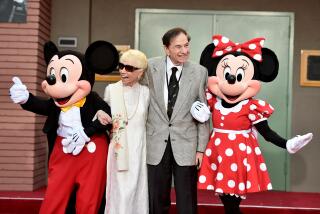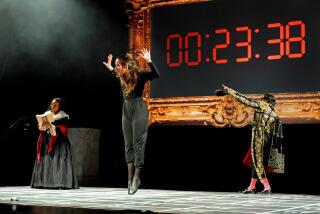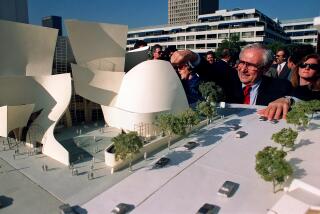Woody Herman--Elegy for a Swing Giant : Tragic Coda to a Life That Spanned Half a Century of Musical Achievement
It seems cruelly unjust that the last months of Woody Herman--who died Thursday--should have been spent enveloped in tragedy. His was a life marked by so much joy of achievement. The outpouring of sympathy, the outflow of funds to help him in that final crush of physical and economic disaster, reflected a deep love of the man that crossed all lines of age, sex, race or musical preference; but none of the noble gestures could erase the memory of an anticlimactic end to a triumphant career that spanned more than half a century.
Essentially, there were three main stages in the evolution of the Herman orchestra: the early Band That Played the Blues, the poll-winning Second Herd that presented a modernized face with overtones of be-bop, and the Four Brothers band through whose ranks passed such saxophonists as Stan Getz, Zoot Sims, Al Cohn, Jimmy Giuffre, Serge Chaloff and Gene Ammons.
These accomplishments, commemorated on records that are still being reissued, took place during the orchestraâs first decade. But Herman by the late 1940s was enough of a world-class figure to continue dominating the scene, while the personnel and size of his groups fluctuated.
Herman himself, though not a virtuoso musician, somehow lent a fittingly feverish touch with his short, shrill clarinet solos, or brought a Johnny Hodges-like languor to his occasional alto sax ballads. Keeping up with the times, he took up the soprano sax when that instrument became a symbol of the post-Coltrane era.
Hermanâs efforts to keep abreast of developments in music found their outlet in many ways: in the arrangements he commissioned by John Coltrane and Chick Corea; in the extended concert pieces contributed by such promising young writers as Alan Broadbent, and in the original jazz works by still newer writers like John Fedchock. But he never forgot, and never neglected, the works that helped establish his worldwide fame, the Ralph Burns and Neal Hefti pieces that remained in his book until the end.
It is too seldom recognized that Hermanâs ranks at one time or another included a long line of black musicians. Ernie Royal, Oscar Pettiford, Gene Ammons, Milt Jackson, Sweets Edison, Nat Adderley, Al Dailey and Byron Stripling all contributed to the legend. His relationship with the sidemen was not that of the typical maestro. âWe never felt we were working for him,â said Nat Pierce, the pianist and composer who performed with Herman off and on for many years. âWe were working with him.â
Difficult though it is to select highlights in a career so rich in historic moments, certain episodes come to mind. In 1945-46 there was his sponsored radio series, a rare honor for any jazz group. In 1946, too, there was the commissioned work from Igor Stravinsky, âEbony Concerto,â with Stravinsky conducting the recording. In 1952-54 his attempt to direct his own company (Mars) produced some exceptional records.
The band went through a so-called âfunk phaseâ in the 1950s and â60s, recording works by Horace Silver and Charles Mingus. In 1976 the Herman Herd celebrated its 40th anniversary with a Carnegie Hall concert that brought Getz, Burns and other graduates back into the fold, just as his 50th-anniversary celebration at the Hollywood Bowl last year pitted the regular band against an all-star alumni orchestra.
Hermanâs death did not mark, as some will no doubt claim, the end of an era. In a sense, the era he symbolized ended with the demise of the swing bands. Like a handful of others, he was a survivor. To the cries that the big bands were dead, he issued, through his long succession of Young Thundering Herds, a defiant denial. Even while he lay wasting away in a hospital bed, his orchestra kept the flame alive.
That he was forced, through a combination of bad management, bad luck and ill health, to spend his last days so pathetically is hard for those of us who knew him to accept. Though clearly there should have been a more peaceful and appropriate finale to his lifeâs work, we will continue to think of him as we knew him: saluting the thousands at Newport or Monterey, proudly introducing this or that new trumpeter or pianist or singer, acknowledging the standing ovations from coast to coast and country to country, singing that wild out-chorus to âCaldoniaâ while the brass section went berserk. That is the Woody Herman we all expect to remember.
More to Read
The biggest entertainment stories
Get our big stories about Hollywood, film, television, music, arts, culture and more right in your inbox as soon as they publish.
You may occasionally receive promotional content from the Los Angeles Times.










